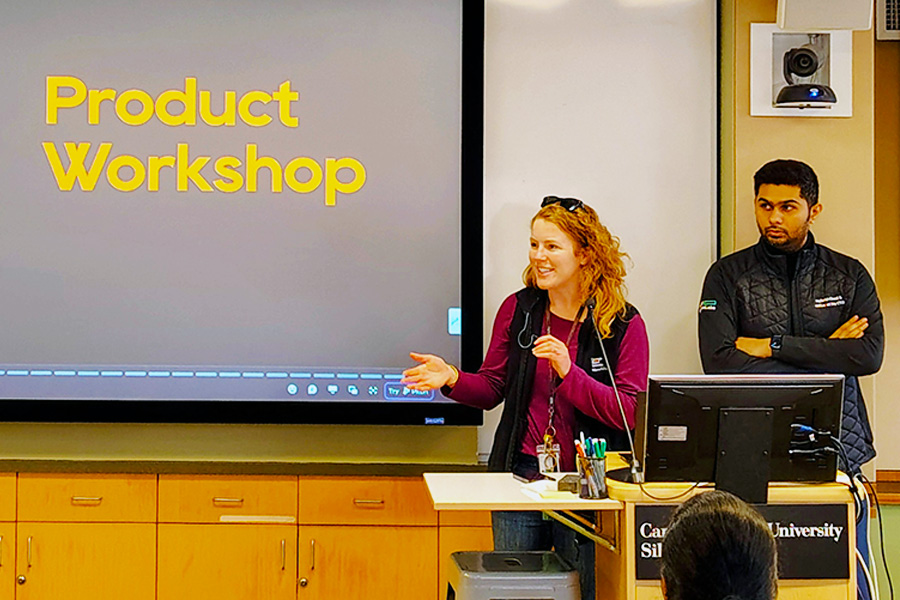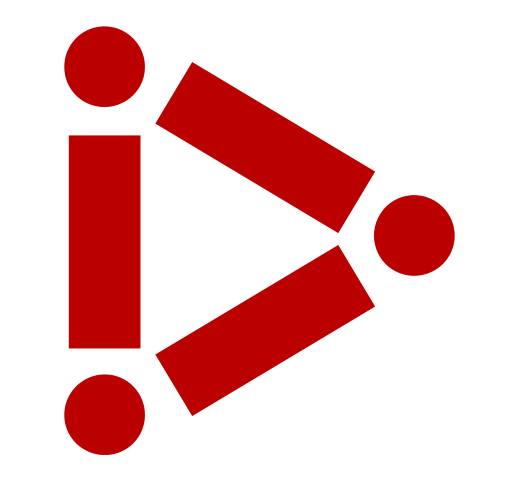
Cracking the PM Interview: Product Insights from Areeb Sanadi
Interviews Are Where Careers Are Made
By Phil Geist
Areeb Sanadi, a Product Manager at Microsoft has seen this firsthand. “Interviews aren’t about perfect answers,” he explains. “They’re about how you think, how you communicate, and how you build a conversation.”
Sanadi’s career began with a bachelor’s degree in Computer Science and four years at VMware, a global leader in cloud computing and virtualization software. Eager to broaden his expertise, he enrolled in the Master of Science in Software Management (MSSM) program at Carnegie Mellon’s Silicon Valley campus, graduating in December 2022.
Following his time at CMU, he contributed to a project at LinkedIn before stepping into his current role at Microsoft. In early 2025, Areeb returned to the Bay Area to lead a product workshop, where he opened his presentation with the question:
“How do we crack our interviews?”
How to Prepare for a Product Manager Interview
What separates great product managers from the rest often comes down to one thing: how they show up in interviews.
Areeb Sanadi emphasized the importance of preparing for the interview process, particularly by going through mock interviews. He explained that mock interviews become especially valuable in the second and third rounds, when companies are evaluating how you think and communicate.
“Mock interviews help you refine your responses and build confidence.”
Areeb also recommends observing how others prepare, learning from common questions, and tailoring your approach based on those insights. He suggests leveraging interview prep resources on platforms like YouTube and PMExercises.com, where you can find various product management interview scenarios and sample questions.
“By building relatability into certain answers—you can learn tips and tricks to improve your product interviews.”
Make a Strong First Impression
One of the most overlooked aspects of a product manager interview is the introduction. Areeb emphasizes that the most important part of the interview is the introduction. Leverage the first two minutes of the call to make an impact and leave a lasting impression. Over time, you’ll see which parts of your story resonate with people and which ones don’t quite land. Keep iterating and tinkering your introduction by changing and chopping your story.
“Studies show that 60% of hiring decisions are made within the first ten minutes of an interview.”
Areeb advises candidates to treat the introduction as a strategic pitch, keeping it crisp, structured, and under two minutes. Focus on the following key points: your education, a brief professional overview, and perhaps a personal interest to humanize your story.
Tailoring your introduction to the interviewer’s expectations is essential. “Put yourself in their shoes,” Areeb suggests. “The best interviews feel like conversations. When the interviewer feels seen and understood, it stands out.” He also encourages candidates to research the company’s mission, values, and initiatives to ensure candidate responses align with the company’s culture and approach.
Finally, Areeb highlights the importance of delivery. Speaking with confidence, maintaining a steady tone and pace, and ensuring your story flows naturally can make a significant difference in shaping the outcome of the interview.
Navigating Open-Ended Questions
Product management interviews often feature open-ended questions, such as “Tell me something about yourself” or “How do you approach ambiguity?” These questions aren’t about providing textbook-perfect answers but instead those questions are meant to provide to demonstrate how you think, solve problems, and adapt to the fast-paced world of product management.
Areeb reassures candidates that there’s no “right” answer. What interviewers want to see is how you break down a problem, communicate your reasoning, and articulate a solution to measure whether or not you’re a good fit. The interviewer wants to test and see if you have enough motivation to to thrive—and stay—in product management.
“It’s about showing your thought process, not just providing the correct answer.”
The Power of Personal Examples
Using personal stories is a great way to stay natural and memorable during an interview. Whether discussing your favorite product or a challenging project, real-world examples illustrate how you apply your thinking in practice. “Personal stories resonate more than abstract theory,” Areeb adds.
Prepare for the Unexpected
You might not be able to predict every interview question, but you can anticipate the general themes by understanding the company’s industry and products. Areeb encourages candidates to be prepared for the unexpected—and to respond in a natural, conversational way rather than relying on rehearsed answers. Areeb emphasizes it’s not about delivering a perfect script—it’s about showing how you handle impromptu questions and how well you think on your feet.
Research Your Interviewer
Whenever possible, research your interviewer’s background ahead of time. Look for shared interests or experiences—perhaps they’ve contributed to AI articles, championed mentorship, or been active in community initiatives. Referencing these points during your conversation can create a natural connection and demonstrate that you’ve done your homework.
Establishing common ground can shift the tone of an interview from formal to conversational, leaving a strong impression of you as an engaged and thoughtful candidate.
Take a Moment Before You Answer
After the introduction, the next piece of the interview is the product design question. When you're asked a product question, don’t be afraid to pause for 30 seconds to a minute to gather your thoughts. You can even say something like, “Do you mind if I take a moment to think about this deeply?”—it shows you're thoughtful, not reactionary.
Use that time to:
- Ask clarifying questions if anything is unclear.
- Visualize the problem, write down notes, and organize your thoughts.
- Break down the question into smaller parts.
- Look for the deeper “what” and “why” behind the segment.
Taking a moment to think before answering shows you can approach problems with depth and intention, rather than rushing into a response you can’t walk back. Focus on identifying a clear target—like a specific demographic or user segment—and back your ideas with relevant, data-driven insights.
Understanding Customer Pain Points
When tackling product-related interview questions, Areeb stresses starting with empathy. Don’t jump straight to solutions—instead, understand the customer’s pain points and why they matter. Rushing can come off as copying existing ideas, reverse engineering, or missing the real issue.
Anchor your response in tangible outcomes like engagement, revenue, or adoption. Then, think creatively, question assumptions, and explore fresh angles. Original thinking stands out more than recycled ideas.
Areeb also highlights the importance of aligning your ideas with the company’s goals and current industry trends. For example, if the company focuses on AI, being familiar with recent developments shows you’re informed and strategically aligned.
To go further, share multiple ideas. “Present three distinct options and explain why you’d choose one,” he advises. This demonstrates creativity, structured thinking, and confidence in decision making skills— all qualities that reflect a strong product mindset.
Articulating Product Vision
When discussing product vision, it’s important to show that you can think big, go wide, and get creative. Focus on identifying the audience, understanding their needs, and explaining how your solution aligns with the company’s broader initiatives. Go a step further by imagining how the product could evolve over time — where it might grow, what future opportunities it could unlock, and how it fits into the bigger picture. Demonstrating this kind of expansive, forward-thinking approach sets you apart as someone who doesn’t just solve for today, but thinks strategically about what’s coming down the pipeline tomorrow.
Prioritizing with Purpose
When you’re working with multiple product ideas, a smart way to prioritize is by using the RICE framework: Reach, Impact, Confidence, and Effort. This simple yet effective method helps you objectively evaluate and rank ideas by balancing their potential value against the effort required. Many product teams visualize this as a matrix, mapping out ideas based on size to quickly see which ones offer the biggest payoff with reasonable effort. It’s a practical tool for backing your decisions with data, prioritizing trade-offs, and showing how you arrived at your recommendations. More importantly, it demonstrates that you can think strategically, make tough calls, and operate independently — delivering clear, thoughtful priorities without relying on a manager or team to direct every step.
Addressing Pitfalls
It’s just as important to address what won’t work as it is to pitch what will. Take time to talk through any assumptions you’ve made and the potential pitfalls or consequences those assumptions might bring. Being upfront about risks, limitations, or areas of uncertainty shows self-awareness, thoughtful planning, and a willingness to tackle challenges head-on — all qualities product teams value in a collaborator.
Bringing It All Together: Your Story, Strategy, and Fit
Interviewers are looking to understand who you are as a person and product manager, how well you align with the company’s values, and where you can be most effective. For example, companies like Amazon value big thinking paired with frugality.
Behavioral questions test soft skills like conflict resolution and problem-solving under ambiguity. These are in your control, so prepare stories from both college and professional experiences that demonstrate key traits, using relevant keywords to guide your responses.
They may also introduce company-relevant product scenarios to assess your customer focus and relatability. Let the interviewer guide the conversation, but be ready to steer it toward topics like product launch strategy, market fit, and growth planning.
Strong PMs articulate who the product is for, where it fits, and how it will be built. Discuss market size, pricing, customization, and how feedback and data shape product iterations. Use real-world thinking—like profitability analysis from shows like Shark Tank—to showcase strategic, value-driven decision making.
Ultimately, strong interviews balance technical knowledge, empathy, and strategic vision. By preparing thoroughly and leading with intention, you can show up as the product leader companies are looking for.
 "Studies show that 60% of hiring decisions are made within the first ten minutes of an interview."
"Studies show that 60% of hiring decisions are made within the first ten minutes of an interview."
AREEB SANDATI (MSSM '22)
Product Manager, Microsoft
Interview Questions to Ask Areeb
iii: You’ve said interviews are more about how you think than getting the “right” answer. How do you evaluate whether a candidate has strong product thinking during an interview?Areeb Sandati (MSSM '22): Response
iii: What are some common mistakes you see candidates make during the introduction, and how can they improve that crucial first two minutes?
Areeb Sandati (MSSM '22): Response
iii: Can you share a mock interview experience that significantly improved your performance?
Areeb Sandati (MSSM '22): Response
iii: How do you recommend balancing preparation with spontaneity during interviews?
Areeb Sandati (MSSM '22): Response
iii: How do you recommend structuring an introduction—chronologically, thematically, or by impact?
Areeb Sandati (MSSM '22): Response
iii: How can someone test whether their intro resonates with listeners before an actual interview?
Areeb Sandati (MSSM '22): Response
iii: Could you please share more regarding what your thought process or strategy is like when you take a moment before responding to interview questions?
Areeb Sandati (MSSM '22): Response
iii: What role does storytelling play in your day-to-day communication?
Areeb Sandati (MSSM '22): Response
iii: What’s your approach to turning an interview into a conversation?
Areeb Sandati (MSSM '22): Response
iii: I noticed a recurring theme in your presentation: the importance of making something "crisp." Your analogy of "chopping and chopping" resonated with me as representing iterative revision to fully form and clearly express an idea. Could you tell us more about your own revision process and any key insights you'd offer to a current product management student?
Areeb Sandati (MSSM '22): Response
iii: You shared a powerful insight about refrigerator companies focusing on what goes into their appliances, like a can of Coca-Cola, demonstrating a broad product vision. In your product management journey, can you share an experience where your vision significantly expanded or your perspective on a product shifted profoundly through a specific process or strategy?
Areeb Sandati (MSSM '22): Response
